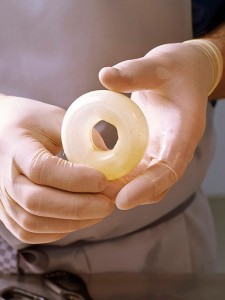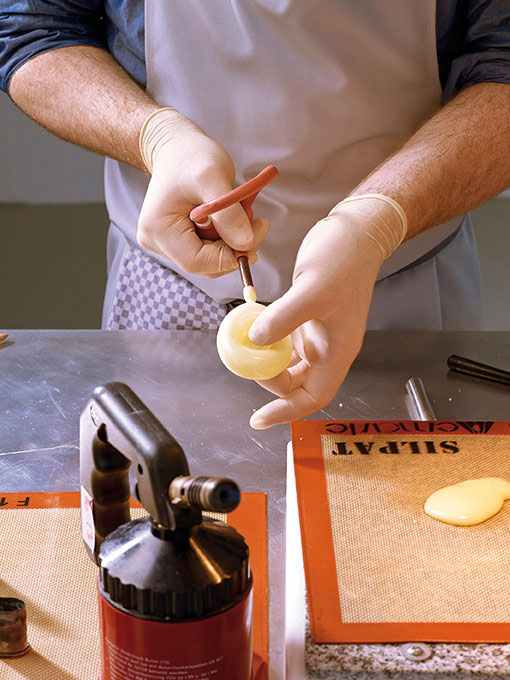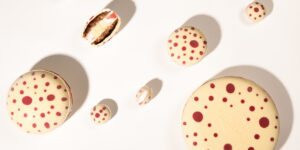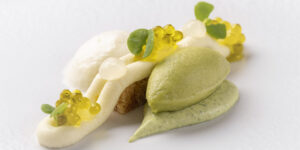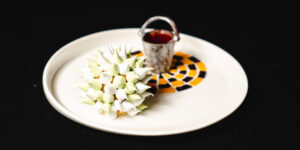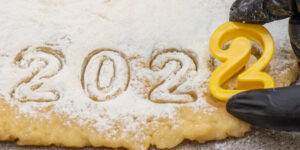Passion Fruit Recipes Plated Desserts Recipes René Frank so good #14
Car ,,O” Nut by René Frank
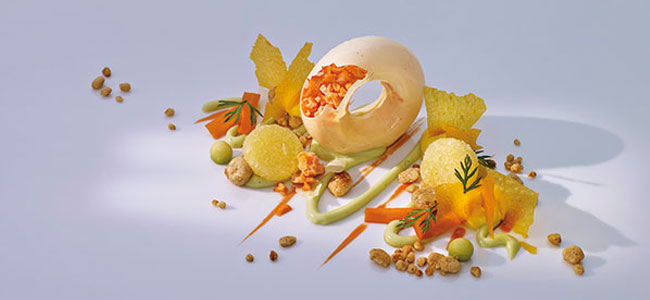
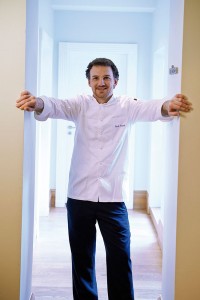 ‘When you look at a dessert you need to see it always in its context. When is it supposed to be eaten? And what did your customer eat in the previous courses? If you have a menu which already contains fruits and a bunch of components made with milk products followed by a cheese course, it makes much more sense to abstain from further milk products in the last course for the sake of your guests’ wellbeing’. So clearly spoke for us René Frank, Executive pastry Chef at the three-starred Relais & Châteaux La Vie (the Chef, Thomas Bühner, appears in so good #7) in Osnabrueck (Germany) for the last five years.
‘When you look at a dessert you need to see it always in its context. When is it supposed to be eaten? And what did your customer eat in the previous courses? If you have a menu which already contains fruits and a bunch of components made with milk products followed by a cheese course, it makes much more sense to abstain from further milk products in the last course for the sake of your guests’ wellbeing’. So clearly spoke for us René Frank, Executive pastry Chef at the three-starred Relais & Châteaux La Vie (the Chef, Thomas Bühner, appears in so good #7) in Osnabrueck (Germany) for the last five years.
His challenge leaves no room for doubt, ‘I want to create a modern pastry where people do not have to think much about calories. And desserts which you do not have to stop eating because you’re full.’ This is the conclusion he reaches after an extensive professional and training career in such illustrious places like l’École Lenotre of Paris, Alain Ducasse Formation, The Culinary Institute of America; three-starred restaurants like Georges Blanc, Vonnas (France); Akelarre, San Sebastián (Spain); Restaurant Kikunoi, Kyoto (Japan); and alongside renowned pastry chefs like Oriol Balaguer in Barcelona. In 2013, he was acclaimed as Pastry Chef of the Year 2013 (Gault & Millau).
This tendency towards lightness is perfectly compatible with creativity and enthusiasm for risk. A good example of this is the desserts which this German chef shares with us in these pages. He dares to elegantly introduce a blown sugar doughnut filled with carrot ice cream which, altogether, revisits the traditional and universal carrot cake. And how about his evocative foam bath, rubber duck included.
In conclusion, balance and good sense when it comes to choosing the ingredients, combinations and quantities, and creative madness regarding the shapes and aesthetics. It sounds quite good as a recipe.
Car ,,O” Nut
The idea for this blown sugar doughnut came through experimenting when I was looking for alternative shapes you can make with blown sugar using it as a part of a dish. For me it is always important that the blown sugar component is not only a visual thing. In this case the sugar content is balanced with the granulated carrot sorbet inside, which is made with non-additional sugar in the recipe. Here we reduced carrot juice in vacuum at 35°C to keep its fresh flavour. It got balanced with a bit of passion fruit for being not so ‘in the face’ bitter and sweet. As I grew up in the south of Germany close to the border of Switzerland, sweet carrot always reminds to the rüblitorte, which is a traditional carrot cake my Grandmother used to feed me with. And she was a master in that cake. The idea of using avocado in a dessert is very common in Thai cuisine, so nothing unusual. Its nutty flavour goes perfect with the hazelnut.
Avocado cream
- 160 g milk
- 0,8 g pectin NH
- 90 g sugar
- 280 g ripe avocado, without stone and skin (approximately 2 pieces)
- 90 g marzipan
- 100 g milk
- 1,5 g salt
- 75 g lemon juice
- 1/2 vanilla pod
- 1 g ascorbic acid
- 20 g Piedmont hazelnuts
- 0,5 g xanthan gum
For the avocado cream, mix the pectin with the sugar and pour into the warm milk. Boil and set aside. In the meanwhile, mix the remaining ingredients, until you obtain a homogenous mass. The nuts are supposed to be completely mixed. Following this, pour in the lightly warm milk mixture. Pass through a strainer and chill.
Saffron isomalt
- 250 g isomalt
- saffron
- 5 drops cream of tartar (50:50 with water)
Bring the isomalt sugar with a pinch of saffron and water to a boil.
Check the temperature with a thermometer.
By reaching 145°C, add the cream of tartar.
At 152°C, turn off the heat.
At 155°C, pour the sugar onto a silpat, chill for a couple of minutes and start pulling. It is then ready to use.
Lime–passion fruit granita
- 100 g lime juice
- 80 g passion fruit pulp without seeds
- 420 g water
- 120 g sugar
- lime zest
Mix all the ingredients for the granita. Strain and freeze until use.
Saffron foam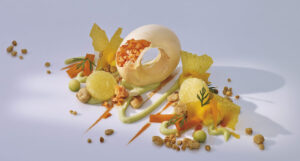
- 300 g milk
- 1,4 g agar agar
- 75 g cream
- 2 g salt
- 3 pinch saffron
- 75 g Ivoire white chocolate
- 1 gelatine leave
Boil the ingredients for the saffron cream for a couple of seconds, add the gelatine and chocolate, emulsify and chill. When cold, mix again, pass through a strainer and fill it in an iSi syphon. It will be ready to use after 2 hours.
Caramelized hazelnut crumble
- 200 g Piedmont hazelnuts without skin and roasted
- 20 g maltodextrin
- 20 g sugar
- 3 g salt
- 30 g water
- 40 g sugar
- 30 g water
For the crumble
Freeze the almonds and mix them to a powder.
In the meanwhile, make a syrup with the maltodextrin, sugar, salt and water. Reduce until thick and add the almond powder. Break the mixture down to small crumbles and roast them until cooked in a pan. If necessary, dry them in the oven or dehydrator at 80°-100°C.
Reduce 40 g of sugar with a tablespoon of water, add the crumble and stir until the sugar starts to crystallise. Now caramelise the sugar while stirring.
Frozen granulated carrot
- 500 g fresh carrot juice
- 200 g fresh passion fruit pulp without seeds
- 75 g orange juice reduction
- 225 g carrot juice reduction
- 25 g lime juice
- 1 g xanthan
- 5 u gelatine leave
We like to prepare the orange and carrot juice reduction in the Vacuum evaporator. So we reduce it under Vacuum at a maximum temperature of 45°C to at least 1/10. This way, we can obtain a clear reduction that is not bitter compared to conventional reductions you make on a stove. We use the natural sugar in the carrot to sweeten this component.
After mixing all the ingredients, dissolve the gelatine in the mass. Transfer to an iSi Whip Syphon, and spray it into liquid nitrogen to obtain a frozen and intense crumble. Set aside before filling the isomalt doughnut with this preparation.
You will find two other very special creations in so good #14
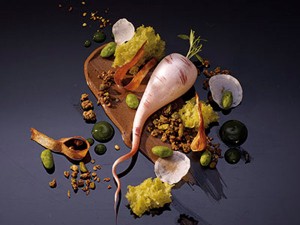 Parsley Root & Pistachio
Parsley Root & Pistachio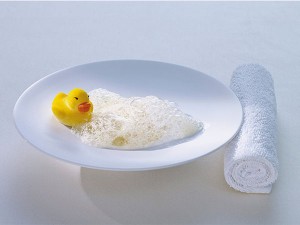 Fluffy Duck
Fluffy Duck